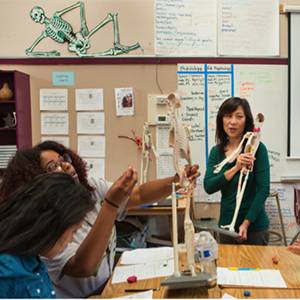
(Photo: Courtesy of Allison Shelley/The Verbatim Agency for American Education: Images of Teachers and Students in Action)
We all know that teaching is a difficult job. Becoming a good teacher with student-centered, inquiry driven PBL curriculum is uniquely difficult—but it gets easier over time. In my nine years as a teacher and five years as instructional coach, I have learned some basic “teacher moves” that consistently help teachers using PBL improve.
Prepare your “go-to” questions
Be prepared to ask different types of questions: initial questions, follow-up questions, and questions that get students to defend their thinking. If we want to develop student critical thinking, communication, and analysis we as teachers need to stop talking, ask more questions and listen. This needs to become a new habit, so prepare some simple questions that you can use over and over. As students begin to expect them you will notice a shift in their depth of responses. Questions that worked for me were:
- Tell me more. (When this is said as a statement it creates an expectation that they can tell you more)
- Why do you think that?
- What evidence do you have for that?
- How does that connect to _____?
- Variations of the above.
Go old-school, with a clipboard
Technology, laptops, and tablets are powerful tools for collecting formative assessment data but don’t forget the reliable clipboard, roster, and pencil. I found this was frequently easier than balancing my laptop and trying to type while looking at and listening to students. Prepare a clipboard for each class, with the class roster listed by student group. This allows you to easily and quickly capture formative assessment evidence as you meet with groups, individuals, and whole class observations. Create columns that indicate what you are looking for and assessing – specific content, collaboration evidence, aspects of written or oral communication, etc. – and use plus, check, minus signs for indicators of proficiency. You can then use this data as purely formative, or maybe they become part of a project’s collaboration score. You also have evidence to support any communication with students’ families and support services.
Create routines of kindness
In our larger social culture of bullying, trolling, and put-downs the act of being kind needs to be intentionally practiced. If we want students to take risks with their learning then they need to feel that the environment is safe. I developed a weekly ‘Circle-O-Kindness’ where the class would gather in a circle on the floor and everyone took turns saying something kind about someone else. It could be some way a classmate helped them, some way they noticed a classmate helping someone else, or a random act of kindness they personally committed that week. Even high school students began to appreciate and look forward to it, reminding me on the day it was scheduled. I learned so much about the students that I would not have known otherwise, and it feels really good!
Trust your students (and their brains!)
The adolescent teen brain is going through the physical stage of strengthening synaptic connections and pruning others away. This synaptic strengthening is a part of learning. The more you can activate and have students practice the types of thinking you want them to learn, the more those synaptic pathways are strengthened. The more the reason for the learning is relevant to their own experience in some way, the easier it becomes for students to show their interest, which then reinforces the natural tendency of human curiosity and learning. I found that the more I trusted my students, the more they would engage with their own learning, which then reinforced my trust in them!
Be clear (as possible) with your intentions
As a teacher, the more clarity you have about what you actually want students to learn the better you can guide their learning and ask better questions. If you want them to think critically about the content and apply it in different authentic situations, then you must ask them to do that and design that into the unit or project plan. This is not about writing learning targets on the board, or in the digital daily agenda. This is about you as teacher intentionally creating opportunities for your students to learn, practice, and get feedback on the skills and knowledge you want them to learn. I find this helps teachers be more reflective of their work and open to improving their own teaching.
These are not the magic spells that will make your every PBL unit unfold smoothly with amazing deeper learning for students! However the more these are practiced, along with using Gold Standard Project Design Elements, your PBL teaching will improve.
What has helped your PBL teaching improve? Let me know on Twitter @istevenson75 and @BIEpbl
